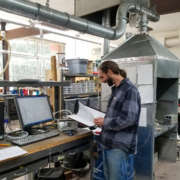Product Development

Why test a stove?
Most of the time, our lab uses testing for product development. If we did not test a stove prototype we would be guessing whether it met expectations. Testing in the lab gets us ready for the field testing of prototypes. Then, customers take the prototype and make it work. The factory and distributors frequently ask for design changes as the product gets closer to shelves. From initial design to market usually takes about a year of testing/iteration/development.
Recently, a factory in Africa asked us to design a $10 wholesale, pellet burning forced draft TLUD prototype that achieves Tier 4 for thermal efficiency, CO, and PM2.5. The stove has to last ten years with scheduled maintenance and require as low wattage as possible.
We had tested the Oorja several times during surveys of commercially available stoves. ARC published the results in books and papers trying to inform the public how stoves compare on various measures of performance. We were trying to make available a Consumer’s Report on stoves (see list below). We knew that the Oorja stove met the Tier rankings and that it used a high mass, low cost, durable combustion chamber. We tried a castable refractory in the lab and we also found several manufacturers that make inexpensive ceramic combustion chambers.
The factory wants a high-powered stove to meet the needs of cooks in their region. Protecting health is also a major concern. Delivering a design that can be made for $10 is also very important. All the interconnected partners in the business plan have to make a healthy profit to bring a “Tier 4” technology to the public. The designer is only the first step in a web of stakeholders.
After all of the necessary parts were combined in the lab, testing with the LEMS (Laboratory Emissions Monitoring System) started. Many iterations were needed to get close to optimal performance. Adjusting the primary and secondary air at high power took experimentation. In several weeks of daily testing, the prototype was repeatedly achieving best scores. A CAD drawing was made and the design was sent to the factory. The factory is making their version of the stove, we will test it here and make adjustments if needed, and then field testing of the prototypes will begin, including home trails and test sales in stores.
Does it sound like a lot of work? The payback to know, rather than guess, that the product can be successfully sold. It’s great to make data based decisions, and a careful approach attracts investment. Failing miserably with products we loved (and lost money on) has made ARC consider external input carefully, especially from field testing.




Leave a Reply
Want to join the discussion?Feel free to contribute!